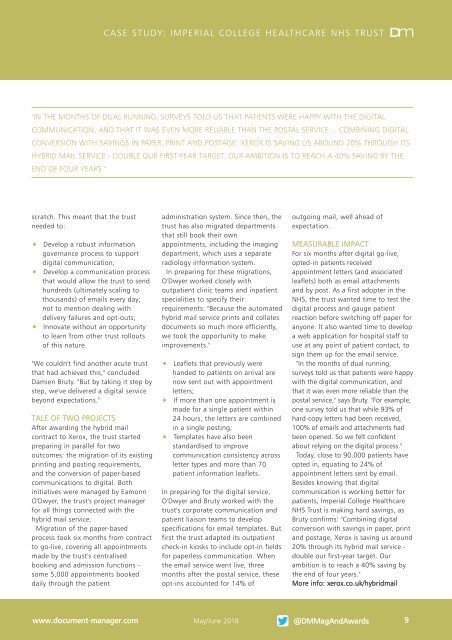You also want an ePaper? Increase the reach of your titles
YUMPU automatically turns print PDFs into web optimized ePapers that Google loves.
CASE STUDY: IMPERIAL COLLEGE HEALTHCARE NHS TRUST Dm<br />
"IN THE MONTHS OF DUAL RUNNING, SURVEYS TOLD US THAT PATIENTS WERE HAPPY WITH THE DIGITAL<br />
COMMUNICATION, AND THAT IT WAS EVEN MORE RELIABLE THAN THE POSTAL SERVICE… COMBINING DIGITAL<br />
CONVERSION WITH SAVINGS IN PAPER, PRINT AND POSTAGE, XEROX IS SAVING US AROUND 20% THROUGH ITS<br />
HYBRID MAIL SERVICE - DOUBLE OUR FIRST-YEAR TARGET. OUR AMBITION IS TO REACH A 40% SAVING BY THE<br />
END OF FOUR YEARS."<br />
scratch. This meant that the trust<br />
needed to:<br />
Develop a robust information<br />
governance process to support<br />
digital communication;<br />
Develop a communication process<br />
that would allow the trust to send<br />
hundreds (ultimately scaling to<br />
thousands) of emails every day;<br />
not to mention dealing with<br />
delivery failures and opt-outs;<br />
Innovate without an opportunity<br />
to learn from other trust rollouts<br />
of this nature.<br />
"We couldn't find another acute trust<br />
that had achieved this," concluded<br />
Damien Bruty. "But by taking it step by<br />
step, we've delivered a digital service<br />
beyond expectations."<br />
TALE OF TWO PROJECTS<br />
After awarding the hybrid mail<br />
contract to Xerox, the trust started<br />
preparing in parallel for two<br />
outcomes: the migration of its existing<br />
printing and posting requirements,<br />
and the conversion of paper-based<br />
communications to digital. Both<br />
initiatives were managed by Eamonn<br />
O'Dwyer, the trust's project manager<br />
for all things connected with the<br />
hybrid mail service.<br />
Migration of the paper-based<br />
process took six months from contract<br />
to go-live, covering all appointments<br />
made by the trust's centralised<br />
booking and admission functions -<br />
some 5,000 appointments booked<br />
daily through the patient<br />
administration system. Since then, the<br />
trust has also migrated departments<br />
that still book their own<br />
appointments, including the imaging<br />
department, which uses a separate<br />
radiology information system.<br />
In preparing for these migrations,<br />
O'Dwyer worked closely with<br />
outpatient clinic teams and inpatient<br />
specialities to specify their<br />
requirements: "Because the automated<br />
hybrid mail service prints and collates<br />
documents so much more efficiently,<br />
we took the opportunity to make<br />
improvements."<br />
Leaflets that previously were<br />
handed to patients on arrival are<br />
now sent out with appointment<br />
letters;<br />
If more than one appointment is<br />
made for a single patient within<br />
24 hours, the letters are combined<br />
in a single posting;<br />
Templates have also been<br />
standardised to improve<br />
communication consistency across<br />
letter types and more than 70<br />
patient information leaflets.<br />
In preparing for the digital service,<br />
O'Dwyer and Bruty worked with the<br />
trust's corporate communication and<br />
patient liaison teams to develop<br />
specifications for email templates. But<br />
first the trust adapted its outpatient<br />
check-in kiosks to include opt-in fields<br />
for paperless communication. When<br />
the email service went live, three<br />
months after the postal service, these<br />
opt-ins accounted for 14% of<br />
outgoing mail, well ahead of<br />
expectation.<br />
MEASURABLE IMPACT<br />
For six months after digital go-live,<br />
opted-in patients received<br />
appointment letters (and associated<br />
leaflets) both as email attachments<br />
and by post. As a first adopter in the<br />
NHS, the trust wanted time to test the<br />
digital process and gauge patient<br />
reaction before switching off paper for<br />
anyone. It also wanted time to develop<br />
a web application for hospital staff to<br />
use at any point of patient contact, to<br />
sign them up for the email service.<br />
"In the months of dual running,<br />
surveys told us that patients were happy<br />
with the digital communication, and<br />
that it was even more reliable than the<br />
postal service," says Bruty. "For example,<br />
one survey told us that while 93% of<br />
hard-copy letters had been received,<br />
100% of emails and attachments had<br />
been opened. So we felt confident<br />
about relying on the digital process."<br />
Today, close to 90,000 patients have<br />
opted in, equating to 24% of<br />
appointment letters sent by email.<br />
Besides knowing that digital<br />
communication is working better for<br />
patients, Imperial College Healthcare<br />
NHS Trust is making hard savings, as<br />
Bruty confirms: "Combining digital<br />
conversion with savings in paper, print<br />
and postage, Xerox is saving us around<br />
20% through its hybrid mail service -<br />
double our first-year target. Our<br />
ambition is to reach a 40% saving by<br />
the end of four years."<br />
More info: xerox.co.uk/hybridmail<br />
www.document-manager.com<br />
May/June 2018<br />
@DMMagAndAwards<br />
9

















